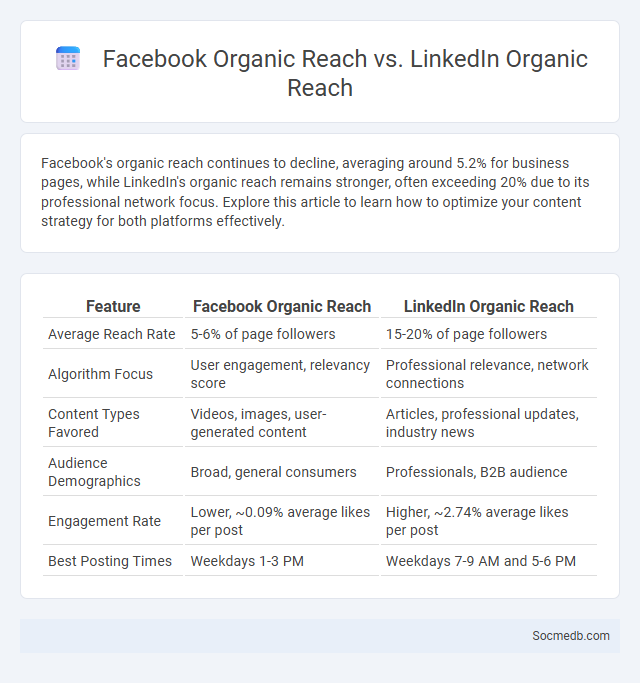
Photo illustration: Facebook Organic Reach vs LinkedIn Organic Reach
Facebook's organic reach continues to decline, averaging around 5.2% for business pages, while LinkedIn's organic reach remains stronger, often exceeding 20% due to its professional network focus. Explore this article to learn how to optimize your content strategy for both platforms effectively.
Table of Comparison
| Feature | Facebook Organic Reach | LinkedIn Organic Reach |
|---|---|---|
| Average Reach Rate | 5-6% of page followers | 15-20% of page followers |
| Algorithm Focus | User engagement, relevancy score | Professional relevance, network connections |
| Content Types Favored | Videos, images, user-generated content | Articles, professional updates, industry news |
| Audience Demographics | Broad, general consumers | Professionals, B2B audience |
| Engagement Rate | Lower, ~0.09% average likes per post | Higher, ~2.74% average likes per post |
| Best Posting Times | Weekdays 1-3 PM | Weekdays 7-9 AM and 5-6 PM |
Understanding Organic Reach: Definition and Importance
Organic reach refers to the number of unique users who see your content on social media platforms without paid promotion. Understanding organic reach is crucial for measuring the effectiveness of your content strategy and assessing genuine audience engagement. Maximizing organic reach helps improve brand visibility and fosters authentic connections with your target audience.
Facebook Organic Reach: Current Trends and Challenges
Facebook organic reach has significantly declined due to algorithm changes prioritizing meaningful interactions, making it harder for brands to connect with their audience without paid promotion. Current trends emphasize creating authentic, engaging content to boost organic visibility and foster community engagement. To improve your Facebook organic reach, focus on interactive posts, leveraging video content, and encouraging user-generated content.
LinkedIn Organic Reach: Opportunities for Professionals
LinkedIn organic reach offers professionals unique opportunities to build authentic connections and expand their network without paid advertising. By consistently sharing valuable content and engaging with industry-relevant discussions, your profile can attract higher visibility and trust among peers and potential employers. Leveraging LinkedIn's algorithm to prioritize meaningful interactions enhances your professional brand and leads to increased career growth opportunities.
Key Differences Between Facebook and LinkedIn Organic Reach
Facebook's organic reach heavily relies on engaging and shareable content that resonates with diverse audiences through posts, videos, and stories, while LinkedIn's organic reach centers on professional and industry-specific content, emphasizing networking and thought leadership. Facebook's algorithm prioritizes content from friends, family, and pages users interact with frequently, whereas LinkedIn's algorithm favors posts from connections, group members, and credible sources relevant to users' professional interests. As a result, Facebook achieves broader but less targeted visibility, whereas LinkedIn offers more precise engagement within niche professional communities.
Algorithm Factors Impacting Organic Reach on Facebook
Facebook's organic reach is heavily influenced by algorithm factors such as user engagement, relevance score, and content type. Posts that generate meaningful interactions like comments and shares are prioritized, increasing visibility in users' news feeds. Timeliness and video content also play critical roles, with Facebook favoring recent posts and native videos to boost organic reach.
How LinkedIn’s Algorithm Shapes Organic Visibility
LinkedIn's algorithm prioritizes content relevance, user engagement, and professional connections to enhance organic visibility. Posts featuring genuine interactions, comments, and shares from relevant industry peers are more likely to appear in users' feeds, increasing exposure. Consistent, high-quality content aligned with user interests and professional expertise drives sustained reach within LinkedIn's network.
Content Types That Boost Organic Reach on Facebook vs LinkedIn
Video content drives higher engagement and organic reach on Facebook by capturing attention quickly and encouraging shares, while LinkedIn favors professional articles and infographics that provide industry insights and thought leadership. Facebook's algorithm prioritizes interactive posts such as live videos and polls, whereas LinkedIn's platform emphasizes value-driven content like detailed case studies and expert commentary. Tailoring your content strategy to these platform-specific preferences boosts your organic visibility and audience growth effectively.
Strategies to Improve Organic Reach on Both Platforms
Optimizing organic reach on social media platforms involves leveraging consistent, high-quality content tailored to audience preferences and platform algorithms. Engaging with followers through timely responses and interactive features like polls or stories fosters community growth and increases visibility. Utilizing targeted hashtags and analyzing performance metrics allows for refined content strategies that align with trending topics and user behavior patterns.
Measuring and Analyzing Organic Reach Effectiveness
Measuring and analyzing organic reach effectiveness involves tracking metrics such as impressions, engagement rates, and audience demographics to understand how content resonates without paid promotion. Utilizing tools like Facebook Insights, Instagram Analytics, and Twitter Analytics provides detailed data on user interactions and content performance. Continuous analysis helps optimize posting strategies, content types, and timing to maximize organic visibility and foster authentic audience growth.
Future Outlook: The Evolution of Organic Reach on Social Media
Organic reach on social media is expected to evolve through enhanced AI algorithms that prioritize authentic engagement and personalized content delivery. Platforms will increasingly leverage machine learning to identify user preferences, boosting visibility for organically shared posts that foster genuine community interaction. This shift aims to balance user experience with advertiser interests, steering brands toward more creative, value-driven content strategies.
 socmedb.com
socmedb.com